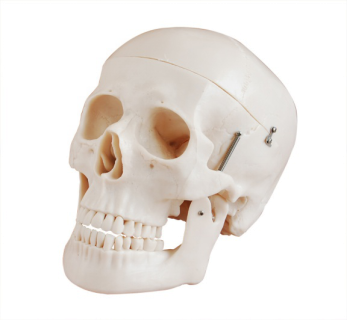Welcome to visitShanghai Chinon medical Model & Equipment Manufacturing Co., LTD
Skull models play a vital role in medical education, helping us bridge the gap in anatomical cognition in an intuitive, concrete way, making complex anatomical structures easy to understand and remember. The following details how the skull model accomplishes this.

First, the skull model provides students with a three-dimensional learning object by accurately simulating the shape and structure of the real skull. Compared with flat illustrations and two-dimensional image data, three-dimensional models can make students more intuitive to feel the three-dimensional sense and spatial relationship of the skull. This intuitiveness greatly reduces the difficulty for students to understand complex anatomical structures, allowing them to build up an overall understanding of the skull more quickly.
Second, the skull model allows students to interact with it, thereby deepening their understanding of the anatomy. Many modern skull models have functions such as detachable and rotatable, and students can personally split and combine the models to observe the connection and relative position of different bone pieces. This hands-on process not only enhances students' involvement and interest, but also enables them to deepen their knowledge of anatomy in practice.
In addition, the skull model can help students build cognitive Bridges from the macro to the micro. When looking at the skull model, students can first understand the shape and structure of the skull as a whole, and then gradually delve into the individual details. By comparing different areas and levels of anatomy, students can gain a more complete understanding of the complexity and diversity of the skull. This cognitive process from macro to micro helps to cultivate students' ability of system thinking and comprehensive analysis.
Finally, the skull model also has an important auxiliary teaching role in medical education. Teachers can use the skull model for classroom demonstration, explanation and question answering, so that students can more clearly understand the key and difficult points of anatomical structure. At the same time, the skull model can also be used as an exam and assessment tool to help students test their learning results and mastery. This diversified teaching method not only improves the teaching effect and quality, but also promotes the students' independent learning and inquiry spirit.
To sum up, skull model plays an irreplaceable role in medical education due to its intuitiveness, interaction and auxiliary teaching characteristics. They help students bridge the gap in anatomical cognition, making complex anatomical structures easy to understand and remember. Therefore, in the process of medical education, we should pay full attention to the application and promotion of skull model.
|
NEXTпјҡWhich medical fields are preterm infant models widely used
LASTпјҡHow does a child CPR model help improve first aid skills |
Return list |